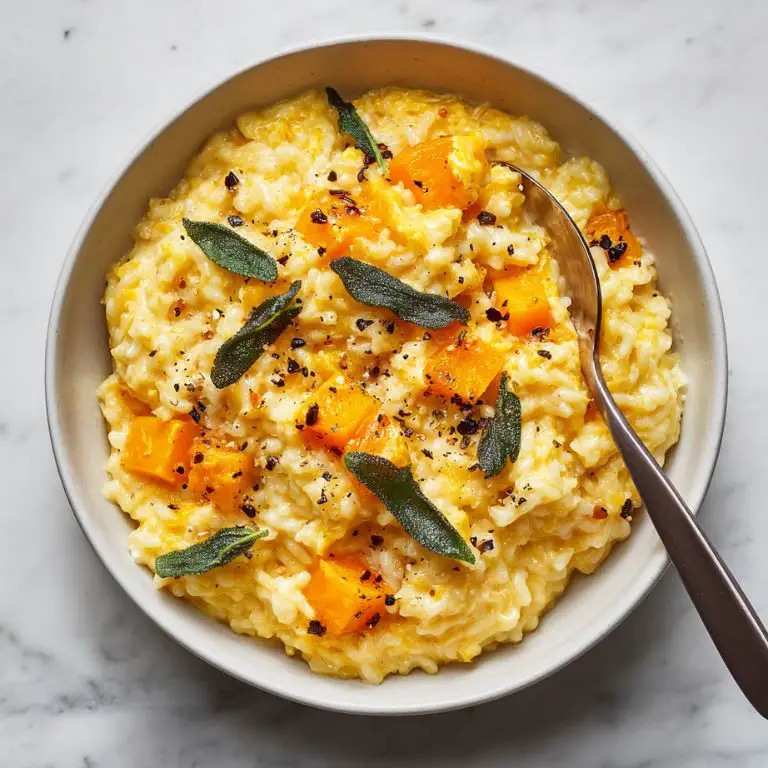There’s something undeniably cozy about a bowl of risotto—warm, creamy, and rich with flavor. This vegan kabocha squash risotto with sage and white wine hits all those comfort notes, without the heaviness of dairy or meat. Kabocha squash, often overlooked in favor of more common varieties like butternut or acorn, brings a naturally sweet, chestnut-like flavor and buttery texture to this dish. When blended into risotto, it transforms the whole experience into something lush and deeply satisfying—perfect for chilly nights or a fall-themed dinner party. This kabocha squash recipe vegan twist is easy enough for a weeknight but elegant enough for a special occasion.
Creamy Vegan Kabocha Squash Risotto with Sage and White Wine
Prep Time 20 minutes mins
Cook Time 45 minutes mins
Total Time 1 hour hr 5 minutes mins
Course Main Course
Cuisine Italian
Large heavy-bottomed pot or Dutch oven Ideal for slow, even cooking of risotto. If you don’t have one, a deep skillet or sauté pan will do.
Blender or immersion blender To purée the roasted kabocha squash until smooth. If you don’t have either, a potato masher can work for a rustic texture.
Baking sheet For roasting the squash.
Ladle Essential for gradually adding broth to the risotto.
Wooden spoon or silicone spatula For gently stirring the risotto as it cooks.
For the risotto
- 1 small kabocha squash about 2.5 to 3 lbs, peeled, deseeded, and cut into cubes
- 2 tablespoons olive oil
- 1 small yellow onion finely chopped
- 3 cloves garlic minced
- 1 ½ cups Arborio rice short-grain rice
- ¾ cup dry white wine Sauvignon Blanc or Pinot Grigio work well
- 4 –5 cups vegetable broth warmed
- 1 tablespoon fresh sage finely chopped (or 1 teaspoon dried)
- ½ teaspoon salt adjust to taste
- Freshly cracked black pepper to taste
- ¼ teaspoon ground nutmeg optional but lovely
- 2 tablespoons nutritional yeast adds a subtle cheesy flavor
- 1 tablespoon vegan butter or more olive oil for finishing
Optional garnish: fried sage leaves or chopped parsley
Roast the Kabocha Squash
Preheat your oven to 400°F (200°C). Spread the cubed kabocha squash on a baking sheet. Drizzle with 1 tablespoon of olive oil and sprinkle lightly with salt. Roast for 25–30 minutes, or until fork-tender and slightly caramelized on the edges.
Once cooled slightly, transfer the roasted squash to a blender with ½ cup of warm broth and blend until smooth. Set aside.
Note: If you’re a fan of roasted squash recipes like roasted acorn squash recipes or roasted kabocha squash, you’ll appreciate how roasting enhances the squash’s natural sweetness here.
Sauté Aromatics
In your heavy pot or Dutch oven, heat the remaining tablespoon of olive oil over medium heat. Add the chopped onion and sauté for 5–6 minutes, until translucent. Stir in the minced garlic and sage, cooking for another minute until fragrant.
Toast the Rice
Add the Arborio rice and stir to coat with the onion and oil mixture. Let it toast for about 2 minutes, stirring frequently. You want the grains to get just a hint of color—this step adds depth.
Deglaze with White Wine
Pour in the white wine and stir continuously until the liquid is mostly absorbed. This step adds brightness and complexity to the risotto.
Begin the Slow Stirring Dance
Start ladling in the warm broth, one ladleful at a time. Stir gently and constantly, allowing the rice to absorb the liquid before adding more. This process should take about 25 minutes. You might not need all the broth—just stop when the rice is al dente and the mixture is creamy.
Add the Squash Purée
Once your risotto is nearly done, stir in the squash purée, nutmeg, salt, and pepper. Cook for another 5 minutes, allowing the flavors to meld beautifully. Finish with nutritional yeast and vegan butter for that final silky touch.
Garnish and Serve
Serve hot, garnished with fried sage leaves or chopped parsley. A crack of black pepper on top seals the deal.
Pairings
This risotto is deeply comforting, creamy, and earthy—so it pairs well with contrasting textures and bright flavors:
- Crisp green salad: A simple mix of arugula, lemon vinaigrette, and toasted nuts balances the richness.
- Roasted vegetables: Think roasted Brussels sprouts, carrots, or parsnips for a hearty, fall-themed plate.
- White wine: Serve the same dry white wine you used in the risotto—Sauvignon Blanc or Pinot Grigio.
- Soup starter: Begin your meal with a light vegan pumpkin soup or even a kabocha squash soup for a seasonal duo.
FAQs
1. Can I use other types of squash instead of kabocha?
Yes! Butternut, acorn, or even delicata squash can work. For a more traditional spin, try some easy acorn squash recipes or vegan butternut squash recipes. However, kabocha’s creamy, non-watery texture gives this risotto its signature richness.
2. Do I have to roast the squash first?
Roasting the squash enhances its sweetness and depth. But if you’re short on time, you can steam it instead—though you’ll sacrifice a bit of that roasted flavor. If you're exploring how to cook acorn squash or kabocha in general, roasting is your best bet for flavor.
3. Can I make this risotto ahead of time?
Yes, but risotto is always best fresh. To prep ahead, you can roast and purée the squash in advance. Reheat the risotto slowly with a splash of broth to restore creaminess before serving.
4. Can I add protein to this vegan risotto?
Absolutely! Cooked green lentils add an earthy texture and make this a heartier dish. They blend beautifully without overpowering the flavor. This is a great way to work green lentil recipes into your weekly routine.
5. Is this dish gluten-free?
Yes, as long as your vegetable broth and white wine are certified gluten-free. Always double-check labels.
